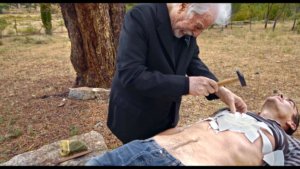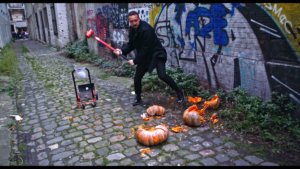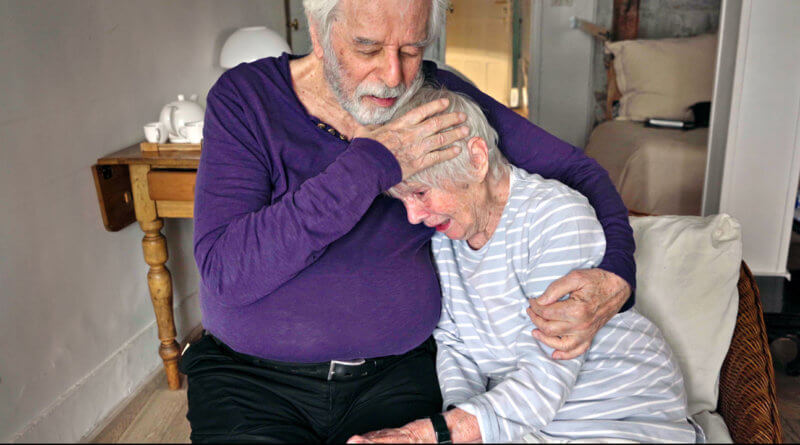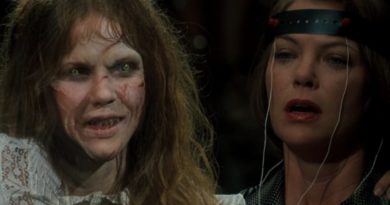Film Review: Alejandro Jodorowsky’s ‘Psychomagic, A Healing Art’
Legendary surrealist director Alejandro Jodorowsky has been many things in his ten decades on earth — musician, mime, artist, novelist, spiritualist and puppeteer, to name just a few lives. Now he becomes a documentarian with his latest film, Psychomagic, A Healing Art.
 Jodorowsky, who virtually invented the ”midnight movie” genre with El Topo and The Holy Mountain, has always had spiritual themes running through his work, no matter how bizarre. With his lifelong fascination of all forms of spirituality and mysticism, a half-century ago he created psychomagic, a form of therapy whose goal is to heal the psychological wounds that people suffer — through unorthodox means. This therapy is based on the belief that the performance of certain acts can directly affect the unconscious mind and release it from trauma.
Jodorowsky, who virtually invented the ”midnight movie” genre with El Topo and The Holy Mountain, has always had spiritual themes running through his work, no matter how bizarre. With his lifelong fascination of all forms of spirituality and mysticism, a half-century ago he created psychomagic, a form of therapy whose goal is to heal the psychological wounds that people suffer — through unorthodox means. This therapy is based on the belief that the performance of certain acts can directly affect the unconscious mind and release it from trauma.
Although it purports to be a documentary, Psychomagic is no less surreal than the director’s narrative works. After he offers a brief explanation of the differences between psychotherapy and psychomagic, the film delves into profiles of the psychologically troubled and his methods of treating them. The first segment is a vintage video of Jodorowsky treating two brothers who howl in anguish as he touches them, wordlessly stroking their torsos, and presses their bodies together as if to force them to become one. Eventually they are joined by their mother, and the segment concludes with the family mutually embracing, seemingly at peace.
From then on the film gets even more bizarre. A child cries out for his mother in the dark. She comes into his room and he tells her that “Darkness is swallowing everything. It will eat us up.” She sings — yes, sings — “It will pass,” and then proceeds to paint his entire body black. Now that he is one with the darkness, he is a “monster of the night,” and is no longer afraid. She strips naked (!) and as their bodies merge, she becomes as black as him.
In another segment, a suicidal drug addict with daddy issues is buried up to his neck and surrounded by raw meat that vultures descend upon. After Jodorowsky shoos them away, he cleanses the man’s body in milk. The symbolism is everywhere.
Most of the film’s segments are structured in a similar way. First, we are introduced to subjects who explain their problems. Then, the unorthodox therapy is performed. Finally, they describe how well they’re coping with life now — in follow-up interviews.
Not surprisingly, family problems are a common complaint among the film’s subjects.
 Between most of the segments, Jodorowsky inserts clips from his narrative films, symbolically tying them to the subject at hand. This device makes the film even more personal and autobiographical. For example, a scene from Endless Poetry is used, showing the lead actor (Alejandro surrogate) chopping down a tree while furiously denouncing his family.
Between most of the segments, Jodorowsky inserts clips from his narrative films, symbolically tying them to the subject at hand. This device makes the film even more personal and autobiographical. For example, a scene from Endless Poetry is used, showing the lead actor (Alejandro surrogate) chopping down a tree while furiously denouncing his family.
It is followed by a scene in which one of his “patients,” for lack of a better term, is setting three pumpkins down on a cobblestone street. After placing the pictures of his father, mother and sister on top of them, he smashes them all into oblivion with a sledgehammer. Then he calmly puts the pictures and some of the smashed pieces into a box and mails it to them.
The most affecting moments occur when when Jodorowsky, truly moved by the woes of these people, embraces them tightly and encourages the tears to flow.
The reason for calling psychomagic “a healing art” becomes quite apparent — it’s equal parts therapy and performance art. Even if viewers dismiss it as just another crackpot “faith healer” scheme, they won’t be able to dismiss the solemn fervor with which Jodorowsky practices it, even when he’s squeezing another man’s testicles in the name of redemption.
Psychomagic, A Healing Art premieres on Friday, Aug. 7 on Alamo on Demand.




